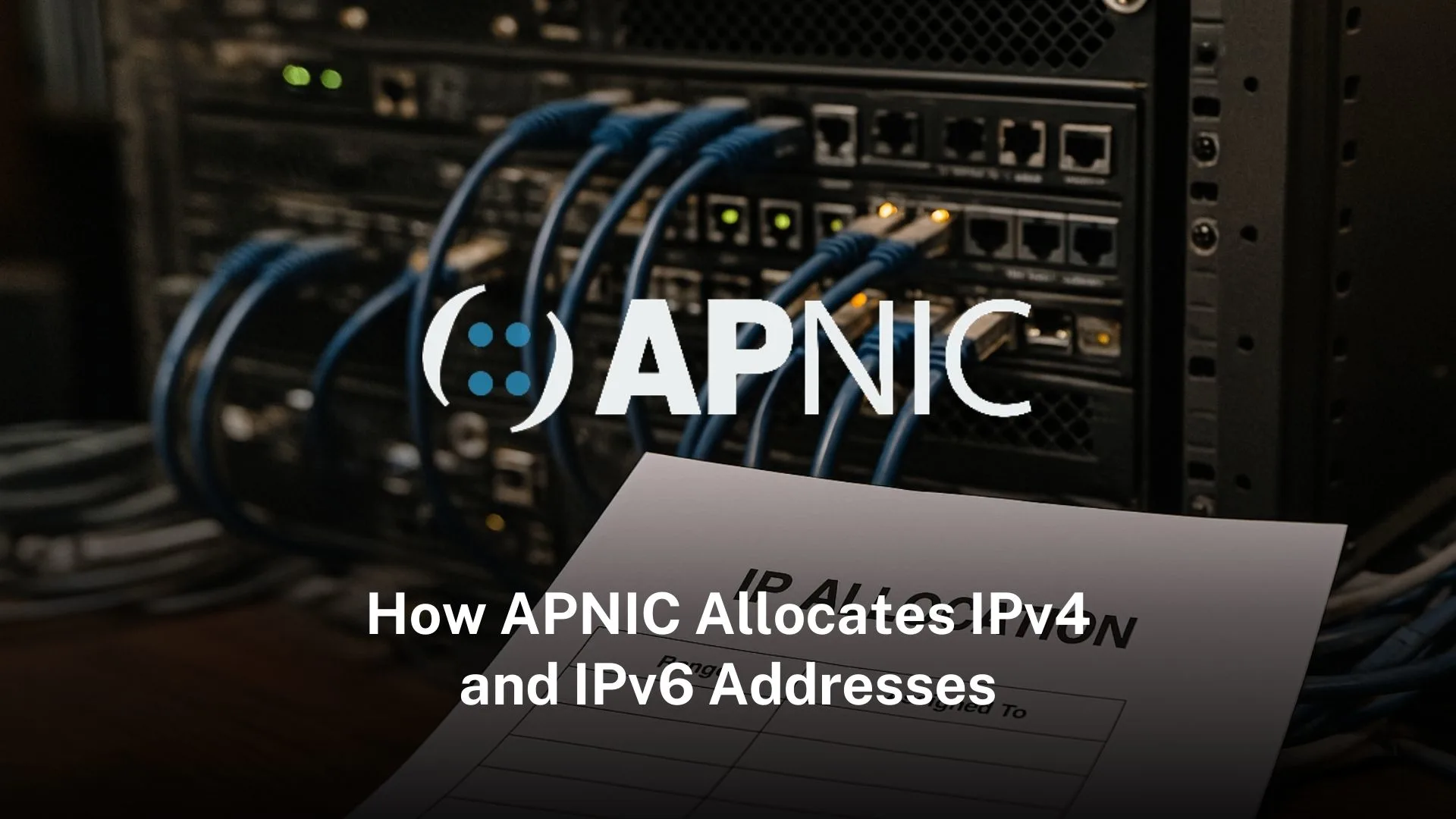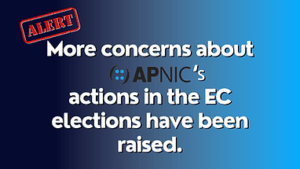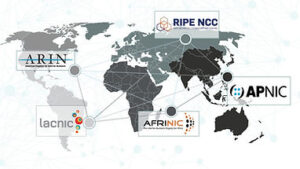APNIC, the Asia-Pacific Network Information Centre, is indispensable in the Internet infrastructure in one of the most vibrant and rapidly evolving regions of the world. As well as these day-to-day responsibilities, the policies for allocating Internet number resources, particularly IPv4 and IPv6 addresses, are critical to network operators, enterprises, cloud providers, and billions of end users who rely on Internet connectivity. This article in the form of an essay explores in depth how APNIC allocates IPv4 and IPv6 address, the policies that govern those allocations, how scarcity and abundance apply to the two protocol versions, and why these policies are important to the global Internet.
APNIC’s role in global Internet governance
APNIC is the RIR for the Asia Pacific region APNIC is a RIR APNIC is one of five Regional Internet Registries that provide allocation and registration services that began in 1992. It receives its allocation from the Internet Assigned Number Authority (IANA), which disburses huge blocks of addresses to the RIRs according to policies that are agreed upon globally. APNIC then assigns these addresses to Local Internet Registries (LIRs), Internet Service Providers (ISPs) and in some cases enterprises, in accordance with regionally based policies. The APNIC model Community self-governed APNIC: Allocation rules are created in the transparent Policy Development Process (PDP) where everybody (network operators, engineers, governments, researchers) can contribute to the policy drafting and agree policies.
This model of governance guarantees justice, openness and responsibility. APNIC policy is not decided in a vacuum, it is forcible out what the community comes to consensus about. This is important, because how APNIC distributes addresses has an impact on global routing, on resource conservation, and on the push for IPv6. In reality, distribution policies have considerable impact not simply in Asia-Pacific but also globally, since the region represents the fastest growing Internet user population.
The principles of address allocation
The five principles of uniqueness, registration, aggregation, conservation, and fairness are the core underlying principles that govern all APNIC allocation and assignment policies. The Uniqueness Guarantee: ensures that all IP addresses are unique globally, so you will never have two networks overlapping. Registration: Allocations need to be registered publicly for transparency and for operational troubleshooting. Aggregation helps reduce bas the size of the global routing table by allocating contiguous, hierarchical blocks. Conservation is important, particularly for IPv4, where the supply is limited. And, there should be a level playing field where no one organization can get Internet number resources unfairly.
These principles are manifested in APNIC’s formal policies, notably APNIC-105 for IPv4 and APNIC-114 for IPv6, which specify not only the criteria for allocations but also the procedural requirements for applicants.
IPv4 allocation in the era of exhaustion
Needs-based allocation
IPv4 allocation at APNIC has long followed a needs-based approach. Applicants for organisations wishing to receive IPv4 resources need to provide extensive documentation of why they need the addresses, how they will use them, and projections of future usage. The policies also explicitly require explanation in cases such as multiple addresses assigned to a single host, or static allocations used for dial-up pools. Technical conservation measures such as dynamic addressing and IP unnumbered point-to-point links are encouraged.
The “final /8” policy
A dramatic change occurred when APNIC reached its final /8 of IPv4 space in 2011. To prevent a land grab and ensure fairness, the “final /8” policy was adopted. This restricts each member to a very small allocation—typically a /22 (1,024 addresses)—from the final pool, regardless of size or need. The policy is designed to ensure that all members, current and future, have some minimal IPv4 space to maintain compatibility and provide basic connectivity. The policy also set aside portions of the final pool for future critical uses.
Implications for applicants
Today, an organisation applying for IPv4 from APNIC can expect only a small allocation under the final /8 policy, unless they engage in IPv4 transfers. The scarcity of new allocations means applicants must increasingly rely on the secondary market, address transfers, or creative technical measures such as Carrier-Grade NAT (CGNAT).
IPv4 transfers and their regulation
The emergence of a transfer market
As the free pool of IPv4 addresses disappeared, a secondary transfer market emerged. APNIC recognised the inevitability of this development and implemented a formal transfer framework. Transfers allow holders of unused IPv4 space to transfer it to others who can demonstrate operational need. Crucially, APNIC requires that all transfers be recorded in the registry to preserve accuracy and prevent unregistered “black market” exchanges.
Inter-RIR transfers
APNIC also takes part in inter-RIR transfers, allowing for the transfer of IPv4 space between regions when policies are compatible. This will make sure the IPv4 market is global and not balkanised by region. Documentation and compliance are necessary to complete such transfers, reflecting APNIC’s commitment to transparency.
Expert concerns
Paul Wilson, APNIC’s Director General, has emphasised that while transfers are pragmatic, they are not a long-term solution. He warns: “The long-term future growth and success of the Internet is dependent on the successful deployment of IPv6.” Reliance on IPv4 transfers and NATs risks undermining end-to-end connectivity, one of the Internet’s founding design principles.
IPv6 allocation: abundance with structure
The philosophy of IPv6 allocation
Unlike IPv4, IPv6 is not scarce. Its address space is vast, making conservation less urgent. Instead, APNIC’s IPv6 allocation policies emphasise routability, aggregation, and operational manageability. APNIC’s guidelines explicitly state that the goals of IPv6 allocation are to provide sufficiently large blocks for aggregation, to promote hierarchical addressing, and to ensure allocations can be globally routed.
Sparse delegation
A key technique APNIC employs is sparse delegation. This algorithm spaces IPv6 allocations widely across the free pool, creating room for organisations to expand their allocations contiguously in the future. This reduces fragmentation and helps ensure the global routing table remains efficient. Sparse delegation is a long-term strategy to avoid the mistakes of IPv4, where fragmentation caused bloated routing tables.
Criteria for IPv6 allocations
To qualify for an initial IPv6 allocation, organisations must demonstrate certain levels of planned use. For example, they might need to demonstrate a plan to make a minimum of 200 assignments over the course of two years, or they may be granted automatically if they are an existing LIR with IPv4 space. The purpose is to give IPv6 only to those organisations that were likely to use them, avoiding waste, and ensuring meaningful usage.
The state of IPv6 deployment
Despite its availability, the adoption of IPv6 has been slow. Geoff Huston from APNIC Labs notes: “We exhausted the pool of unallocated IPv4 addresses more than a decade ago… the shift to IPv6 is happening it’s been ongoing for 25 years, and although the running out of IPv4 addresses should have spurred panic, we’ve been breathing with it for so long that it has numbed us to the problem.” His warning highlights the paradox of IPv6: the solution to scarcity exists, but deployment lags due to operational inertia.
The contrasting dynamics of IPv4 and IPv6 allocation
The relative sizes of the IPv4 and IPv6 allocations at APNIC reflect the peculiarities of the protocol. There is a severe restraint on IPv4 allocations, with justification needed and hold up by exhaustion. On the other hand, IPv6 allocations are plentiful but organised by mechanisms like sparse delegation that prevent long term wastage. Running out of IPv4 has driven the emergence of a transfer market and increased use of NATs, while IPv6 policy aims to encourage native addressing, aggregation, and routability.
This contrast reflects not only different technical realities but also different stages in the Internet’s evolution. IPv4 policies are about eking out the last drops of a finite resource. IPv6 policies are about managing abundance in a sustainable, globally scalable way.
Impacts on different stakeholders
APNIC’s rules for ISPs and LIRs mean that growth in IPv4 requires reliance either on transfers or on NAT, while growth in IPv6 provides a path to long-term scalability. Among cloud providers and content networks, early IPv6 adoption minimizes future costs and guarantees global reach. Enterprises also need to be thinking about IPv6, as counting on expensive IPv4 transfers is not a sustainable long-term strategy.
The role of IANA and global coordination
You have to keep in mind that APNIC does not provision out of its own endless supply. It is given huge chunks from IANA (Internet Assigned Numbers Authority) under policies agreed at global level. With the depletion of IANA’s free pool in 2011, each RIR, including APNIC, implemented post-exhaustion policies. The world-wide coordination IANA has with the RIR’s to keep the Internet a single cohesive system and not broken up into incompatible networks is quite good.
Conclusion
The practices of APNIC in allocating both IPv4 and IPv6 address space show the challenge of dealing both with the management of scarcity as well as abundance. For IPv4, a needs-based allocation policy guides distribution, a final /8 policy was implemented, and transfers are regulated to maintain fairness and prolong the existence of a scarce resource. For IPv6, strict structured, sparse delegation and allocation rules leads to aggregation and routability on what is effectively a space of infinite bits. APNIC leaders such as Paul Wilson and Geoff Huston emphasize that while transfers offer a short-term reprieve, it is only through deploying IPv6 that the long-term growth of the Internet can be assured.
Therefore APNIC policies are not technical application of algorithms but rather essential pieces of the architecture of Internet governance. They are balancing fairness, efficiency, and sustainability across billions of users. In the end, what the experiences of IPv4 depletion and the design of IPv6 allocation policies teach is the importance of policies that are governed by the community in keeping the Internet growing for many decades.
Frequently asked questions
1. Is there still a chance for APNIC to allocate IPv4 addresses to new applicants?
Yes, but the numbers are extremely small. Under the final /8 policy, each applicant can receive a small allocation, typically a /22, regardless of demonstrated need. Larger amounts must be obtained through transfers.
2. What is the sparse delegation algorithm used by APNIC for IPv6?
Sparse delegation spaces allocations widely across the free pool, allowing future contiguous growth and preventing fragmentation. This supports aggregation and keeps routing tables efficient.
3. Why are IPv4 transfers necessary?
With the exhaustion of the free pool, transfers are the only way for organisations to acquire larger IPv4 blocks. APNIC now makes transfers official to maintain the accuracy of the registry and reduce the trading.
4. Is IPv6 adoption mandated by APNIC?
No, APNIC does not force organisations to use IPv6. But its leadership regularly stresses that IPv6 is necessary for the long-term health of the Internet and its allocation policies are structured to promote its use.
5. What impact do APNIC policies have on the global Internet routing?
APNIC‘s policies also have implications for the global routing table. This contributes to scalability and stability throughout the Internet.





Hi there! I’m at work browsing your blog from my new iphone! Just wanted to say I love reading your blog and look forward to all your posts! Carry on the outstanding work!